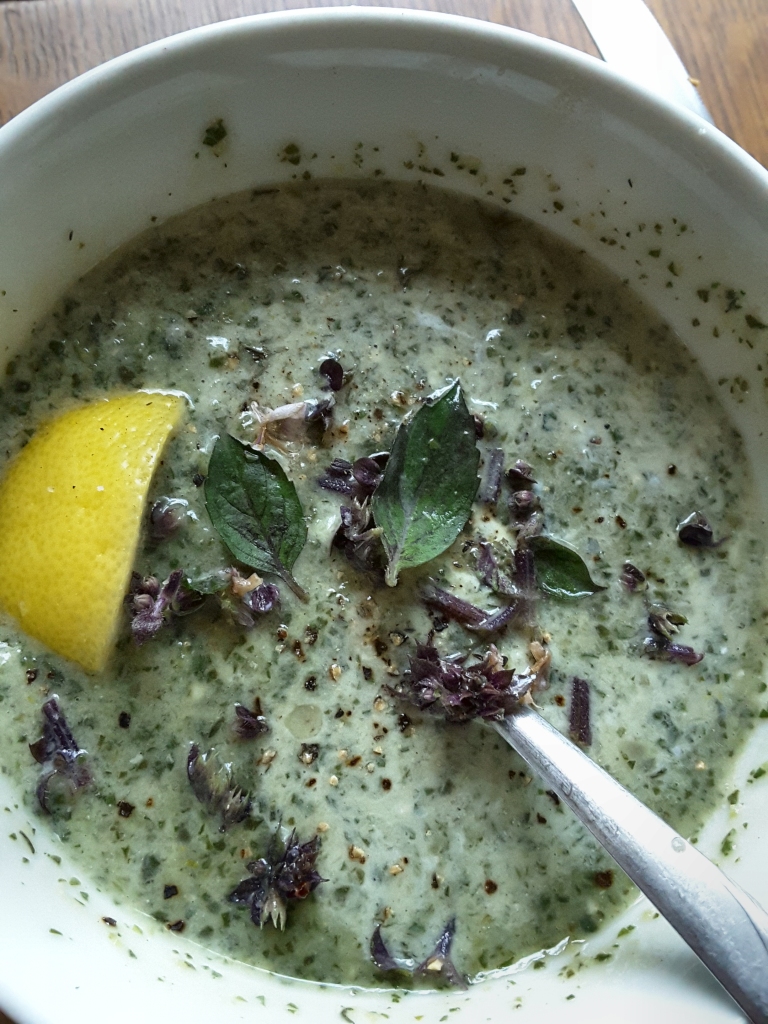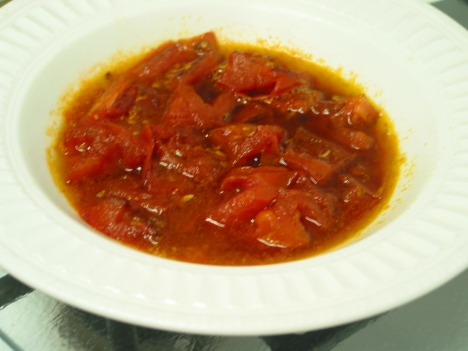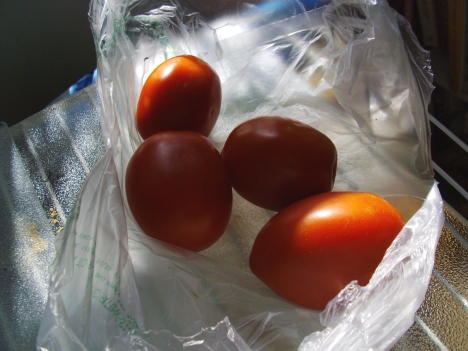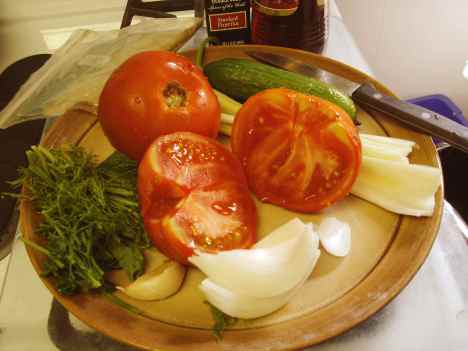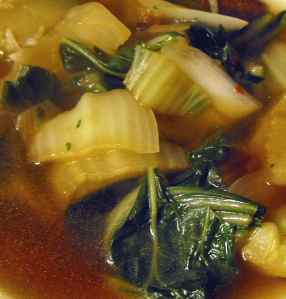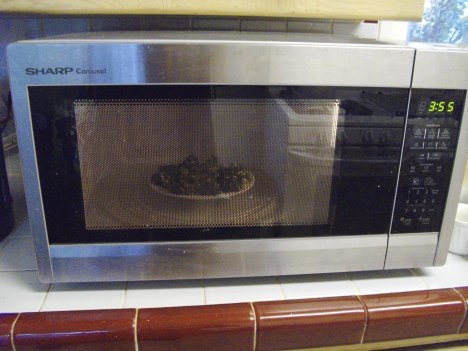
No matter how many times I vow I’m not going to work too hard this year, I always end up cleaning the fridge some time in the small hours the night before Passover, swearing creatively to get all the vegetable bins and shelving back in the way they came out. Between packing out the unkasherable dishes and appliances like the toaster oven, shopping for the week, and kashering the silverware, dishes and pots for Passover, it always ends up about 5 to 6 or so in the evening before I can actually cook.
Passover started Friday night, and it was just us at home this time around for the first seder. So I didn’t have to make a huge menu, which was good. Because I did have to kasher the kitchen–starting after a 3-hour stint at the DMV (my third this month) to help my kid finally get her learner’s permit. Type I diabetes throws a monkey wrench into the proceedings and requires extra time, paperwork, and hocking to make sure one office actually sends the other office the fax within your lifetime…so it was a bit on the late side that I actually got to start, and by the time sunset rolled around, I was kind of wiped and ready to skip it. Not a great frame of mind for experimenting in the kitchen, certainly not that night. Although the fridge IS still astonishingly clean and sparkly.
We don’t always get fully past the rush to the enjoyment of the seder, especially those of us who are doing the cooking. But the first bite of parsley dipped in saltwater always signals the start of the holiday for me, and the first bite of matzah tastes like freedom. (The thirty-fifth bite or so, perhaps not so much…)
By now I’ve played around enough to have quite a number of simple Passover-worthy dishes that can be microwaved, some of them start to finish. That can be handy when you’re either short on cooking time after getting home from work on Friday or just short on patience and yet you still want to do a simple–but still nice–small seder. It might even provide a save at least for the side dishes if you’re doing a bigger one.
Some things you can’t help cooking on the stove–hard-boiled eggs for the seder plate and for the table of hungry guests. And some things like charoset take some hand work to chop if you don’t have a food processor around.
However.
Even if you’re serving something long-cooked like chicken or brisket as a main dish, a couple of easy microwaveable vegetable dishes, appetizers and desserts–even soup–might benefit from not having to compete for stovetop and oven space, particularly if a heat wave is headed your way. And microwaving reaps big benefits for reheating or supplementing leftovers quickly during the next several days if you keep kosher for Passover, or even if you don’t.
Vegetabalia
Fresh vegetables really matter for Passover. Salad, yes. It’s spring, after all (even though my mother said they were expecting another snowfall this week in Boston). And also cooked greens. I’m a big believer in microwaving them lightly and last-minute wherever possible, so that they’re just-cooked, fresh-tasting and still green when you serve them–at least, if they’re supposed to be green.
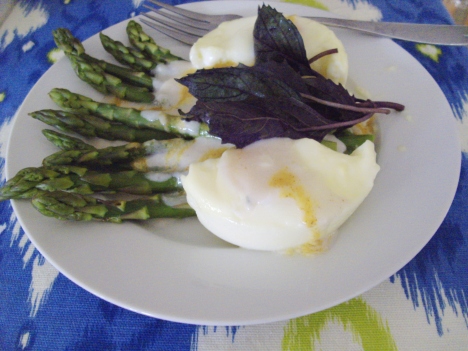
Lightly-microwaved asparagus stays green even the next day. It’s good either cold or reheated with light vinaigrette and a poached egg (regular or microwaved) and some basil or other spring herbs.
Asparagus is traditional, and as long as you don’t abuse it the way my mother [probably] still does, by boiling the regulation seven minutes, shocking in ice water, and then letting it sit around in the cold water for ages until the stalks start shredding into floaty olive-green kelp-like bits, because she’s too busy with the soup, and dinner’s not for another whole hour…..skip all that and microwave the stalks instead for 2-3 minutes and you can be a winner.
Snaplock containers that are about the same size as the amount of vegetable you’re microwaving make it easy to prep ahead and store raw trimmed, washed asparagus, broccoli, brussels sprouts or other greens in the fridge, ready to nuke and go. When you’re ready for them, just add a drizzle of water, maybe a quarter-inch, to the container, put the lid back on, shake once or twice over the sink (in case of drips), and microwave them 2-3 minutes for a pound–you can let them sit a minute or so afterward and they’ll continue to steam. If you’re doing 2 pounds in one container, double the time, but stop and stir gently halfway through so the less-cooked ones on the bottom get moved to the top, and keep an eye on it the last minute or so–that is, stop the microwave again and check with a fork for doneness–so you don’t overcook.
Once the vegetables are just fork-tender and still green, drain them carefully and either serve right away or take the lid off and lay it back on loosely with an air gap–you can probably get away with letting it sit this way for 10 minutes or so without it cooling too much, and the veg will stay green. But obviously, it’s best to serve it fairly quickly.
Vegetables you plan to roast or pan-brown can get a very quick head start in the microwave before tossing quickly with olive oil, garlic and rosemary in a frying pan or, if you’ve already got it going anyway, the oven. The precooking definitely cuts down the browning time. Brussels sprouts, fresh fennel, new potatoes, carrots, and red squashes are easy to microwave with just a bit of water in the bottom of a covered container to help steam them quickly.
Not-Chicken Soups
Microwaveable not-chicken soups, good for a vegetarian, vegan, or fish dinner, can be made ahead in a couple of minutes (well, 5 to 15, including prep time) and reheated. They’re also good to have on hand if you’re doing a big meat dinner with the standard chicken soup in a stock pot but you also have a few vegetarian guests.
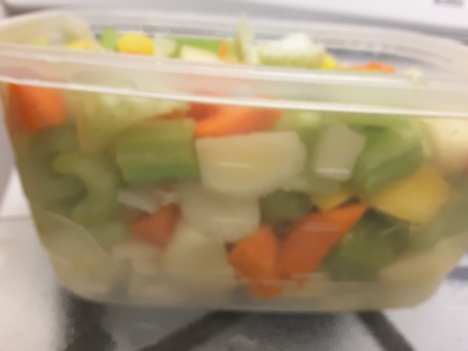
Basic not-chicken soup (about 2 1/2 quarts or 8-10 servings)
- 3-4 full-sized carrots
- medium or large onion
- 4 long stalks of celery
- drizzle/spoonful of olive oil
- fat clove of garlic, minced, mashed or grated
- handful of fresh dill or 1-2 T dry
- 12-20 black peppercorns
- lemon juice and salt to taste at the table
Fill up a 2.5 quart microwaveable bowl or container nearly to the top with chopped (bite-size pieces) vegetables. Stir in a spoonful of olive oil, and microwave-wilt the veg for 5 minutes on HIGH with the lid on. Add a fat minced or grated clove of garlic, a handful of dill and a few black peppercorns, plus water to cover and reheat another 5-6 minutes or until steaming hot, then let it sit with the lid on. Your soup will be pretty flavorful after letting it steep half an hour, if possibly a bit sweet (just one of those leftover mongo onions from last week’s “gifting” weighed a full pound on average). A squeeze of lemon and a dash of salt–not Campbell’s or Lipton’s level salting, salt-shaker-at-the-diner’s-discretion salting–and a grinding of pepper will work it out.
Pan-browned not-chicken soup
The pan-browned minimal carrot-onion soup is a little more hands-on, but very convincing and full-bodied. The basic setup is the same as for plain, but after wilting, pan brown the veg in a nonstick frying pan until you see actual browning, about 10 minutes. Add a grated or minced fat clove of garlic, a sprig of thyme, and a splash of white wine, and cook it down to dry. Put the veg back in the microwave container, swirl a bit of water around the empty pan to pick up the browning (i.e., deglaze), add it to the veg, fill the container up to the top with water, and microwave 5-6 minutes to heat, then let it steep.
My current version (since I was gifted with celery as well last week) includes a couple of chopped stalks of celery with again, a very large onion. I also added in a bit of dill plus–chop ’em if you’ve got ’em–one or two finely-diced shiitake mushrooms, fresh or dried and soaked in half a cup of hot water, for added not-chicken potency.
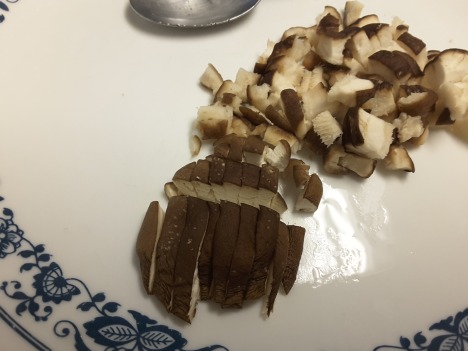
A squeeze of lemon and a dash of salt and fresh ground pepper at the table makes it even better than actual chicken soup. And you never have to skim any scum.
If you want to surprise people, go with bok choy broth but skip the soy sauce (contains wheat) and add extra shiitakes and fresh brown mushrooms, plus scallions, garlic and ginger. Use apple cider vinegar. We think sesame oil is fine for Passover but a lot of people don’t; it’s okay even without it.
Whatever soup you offer, keep the vegetables in. I never really understand the appeal of throwing out good veg just to have a 1950s-style “clear consommé”.
Microwave matzah balls?!
You can, actually, but not the conventional way, at least not in water to cover, mimicking the usual stovetop boiling. I tried it one afternoon last week just to see, using the classic back-of-box recipe just to be sure (I try these things so you don’t have to…). Continue reading →
Filed under: high-speed soup, holiday cooking, Microwave tricks, Vegetabalia | Tagged: food, Jewish cooking, Passover, recipes, vegetarian | Comments Off on A Microwaveable Passover, 5778 (2018) edition





